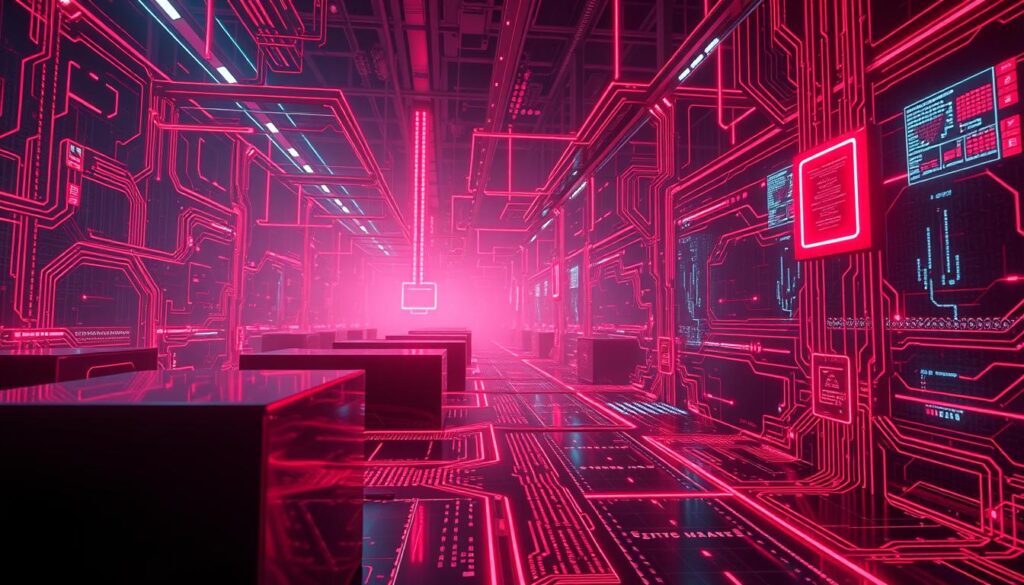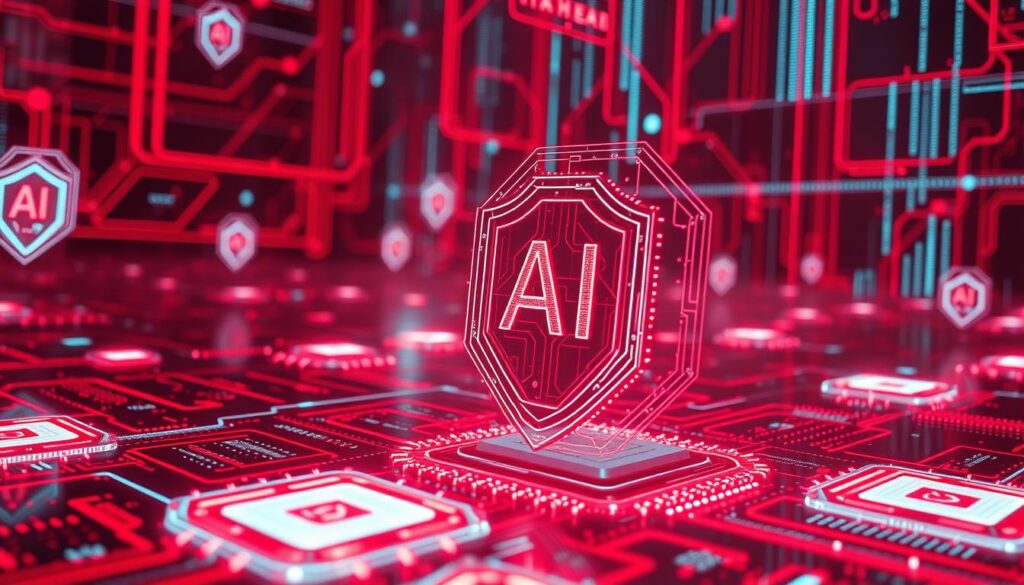Are we ready for the changing cyber threats online? As technology grows, so do the dangers we face. AI-powered threat detection is changing cybersecurity, offering new ways to protect us.
In today’s world, artificial intelligence is changing how we fight threats. AI uses machine learning to quickly scan huge amounts of data. This helps spot threats faster than ever.
Old security methods can’t keep up with new cyber attacks. AI fills this gap with smart, proactive defense. We’re moving from just reacting to threats to actually stopping them before they start.
Let’s dive into how AI is changing digital safety. From analyzing behavior to constant monitoring, AI is setting new standards in keeping us safe online.
Key Takeaways
- AI enhances real-time threat detection capabilities
- Machine learning algorithms reduce false positives in security alerts
- AI-driven behavioral analysis improves unauthorized access detection
- Predictive models enable proactive security measures
- AI integration with blockchain and IoT boosts overall cybersecurity
- Continuous learning is crucial for AI systems to adapt to evolving threats
- AI significantly reduces threat detection and mitigation times
The Evolution of Modern Cybersecurity Landscape

The world of cybersecurity has changed a lot in recent years. We’ve moved from simple viruses to complex threats. These new threats test our defenses in ways we never thought possible.
From Traditional to AI-Powered Security
At first, cybersecurity was based on simple rules. But as threats grew, so did our defenses. The 1980s brought signature-based systems, and the 1990s introduced heuristic detection. Now, AI leads the way in keeping us safe.
Current Challenges in Digital Security
The digital world is full of challenges. Advanced Persistent Threats (APTs) can hide for 286, posing big risks. Old security methods can’t keep up with new threats fast enough.
The Rise of Sophisticated Cyber Threats
Today’s cyber threats are more complex and harmful. The ILOVEYOU virus in 2000 caused over $10 billion in damage. Now, ransomware can hit hundreds of thousands of computers worldwide in one day. This shows we need better ways to find and stop malware.
“The global cybersecurity market is projected to grow from $240 billion in 2022 to $370 billion by 2029, reflecting the increasing demand for robust security solutions.”
AI is helping us tackle these challenges. It’s key for finding and stopping threats. AI in cybersecurity is becoming more important for keeping us safe.
Understanding AI’s Role in Cybersecurity

Artificial intelligence is changing how we protect our digital world. AI systems can look through huge amounts of data fast. They find patterns and oddities that humans might miss.
Machine learning is key to AI’s role in keeping us safe online. These algorithms learn from lots of data quickly. They spot complex and small issues that people might not catch.
- Response times to cyber threats reduced by 50%
- False positives decreased by 30%
- Zero-day vulnerability detection increased by 35%
- Incident response time improved by 45%
AI can handle up to 1 million events per second. This means threats are found and dealt with quickly. It lets security teams focus on real dangers, making our defenses stronger.
“AI will play a critical role in cybersecurity efforts over the next 5 years,” say 60% of security professionals.
The AI in cybersecurity market is growing fast. It’s expected to jump from $12.5 billion in 2020 to $34.9 billion by 2026. This shows how much we’re counting on AI for strong online protection.
Threat Detection and Prevention: Using AI to identify and prevent security threats

AI has changed the game in cybersecurity. In 2024, Fortune 500 companies saw a 35% jump in using advanced threat detection tools. This shows how important AI is in protecting our digital world.
Machine Learning Algorithms in Threat Detection
Machine learning is key to today’s threat detection. It looks at huge amounts of data to spot bad patterns. This way, it keeps getting better at fighting off new cyber threats.
Real-time Analysis and Response
AI makes it possible to quickly check network traffic and system events. This fast action is essential in today’s quick-changing threat world. AI tools can spot and act on threats in seconds, cutting down the damage from cyber attacks.
Predictive Analytics and Risk Assessment
Predictive analytics is a big part of keeping systems safe today. AI looks at past data and current trends to predict future risks. This helps organizations fix problems before they happen. Gartner says 70% of companies will use AI for threat intelligence by 2025.
AI in threat detection is a big step up for cybersecurity. As threats get smarter, AI gives us the edge we need to stay ahead.
Core Components of AI-Powered Security Systems
AI-powered security systems are changing the game in network security and intrusion prevention. They use the latest tech to keep our digital stuff safe better than ever.
Neural Networks and Deep Learning
Neural networks are key to AI security. They work like our brains, looking at lots of data for patterns and oddities. Deep learning makes them even better at spotting threats over time.
Natural Language Processing in Threat Analysis
Natural Language Processing (NLP) is big in threat analysis. It helps make sense of security info from logs, reports, and online talk. This lets AI systems tackle threats more smartly.
Automated Response Mechanisms
AI gives security systems the power to act fast. When a threat is found, they can start fixing it right away, without needing a human. This quick action cuts down on the damage from security breaks.
Companies using AI security systems are seeing big wins. They find and fix data breaches 108 days sooner than those without AI. This saves a lot of money, with AI users saving about $1.76 million on average.
- AI security market value: $20.19 billion in 2023
- Projected growth: $141.64 billion by 2032
- Annual growth rate: 24.2%
As cyber threats keep getting smarter, adding these AI parts to security systems is more important than ever for strong network defense.
Implementation Strategies for AI Security Solutions
Adding AI security to current systems is a big step up in cybersecurity. Companies looking to strengthen their defenses need to plan carefully. They must find ways to smoothly add these new technologies.
First, check how well your current systems work with AI. This check helps spot any problems and figure out if the AI can grow with your needs. Starting small and adding more over time can help avoid big problems.
Good data is key for AI to work well in security. You need lots of different data to train AI to spot and fight threats. Make sure to spend enough on keeping your data clean and safe.
- Conduct a comprehensive system audit
- Develop a phased implementation plan
- Prioritize data quality and integrity
- Train staff on new AI-powered tools
It’s also important to protect AI from its own weaknesses. Use strong encryption and special training methods to keep AI safe. These steps can cut down on bad access by half.
AI in cybersecurity is not just about technology; it’s about creating a symbiotic relationship between human expertise and machine intelligence.
But don’t forget, people are still important in AI security. Make sure your team knows how to work with AI. This teamwork can make finding threats 50% faster than old ways.
Advanced Pattern Recognition and Anomaly Detection
AI is changing how we protect networks. Machine learning can look through huge amounts of data fast. This means it can spot threats in real time, helping us act quickly.
Behavioral Analysis and Profiling
AI is great at understanding how things behave. It knows what’s normal and finds what’s not. This cuts down on false alarms by half, making life easier for security teams.
Network Traffic Analysis
Machine learning looks at network traffic to find odd patterns. It can catch new threats before they’re known. This helps protect us before attacks happen, saving time and effort.
System Event Correlation
AI connects different events to find complex threats. It helps us find hidden dangers. Using AI, companies can spend less on fixing data breaches.
Using AI with current security systems is key. Mixing AI with old methods makes detection better and faster. As technology grows, AI will be more important in keeping our digital world safe.
Integration with Existing Security Infrastructure
AI is changing how we protect our digital world. Merging AI with our current security systems is both exciting and challenging. We’ll look at how to make this integration work, focusing on how well they fit together, data sharing, and growing capabilities.
Legacy System Compatibility
Many companies struggle to mix AI with older security systems. A recent survey shows 34% of businesses use AI in security, and 56% plan to soon. It’s important to plan carefully to make sure everything works well together.
API Integration and Data Flow
Smooth data sharing is key for good cybersecurity. APIs help link AI systems with today’s security tools. This connection helps spot threats fast and cuts down on false alarms, letting teams focus on real dangers.
Scalability Considerations
As threats grow, so does the need for scalability. AI systems must grow with the data and complexity. Companies must check their network’s speed and power to avoid slowdowns in their security setup.
Combining AI with current security tools needs a thoughtful strategy. By tackling compatibility, ensuring data moves smoothly, and planning for growth, businesses can boost their security. This way, they can keep up with new cyber dangers.
Real-time Monitoring and Response Capabilities
Today’s digital world moves fast, and so do cyber threats. Companies use advanced security to protect themselves. They use predictive analytics and AI to stay ahead of threats.
Keeping an eye on the network is key to spotting threats. Security teams watch for unusual activity and user behavior. This helps them catch risks quickly, reducing the chance of cyber attacks.
AI can analyze huge amounts of data fast, better than humans. It’s great at finding new threats, like zero-day exploits and insider attacks. These threats can be hard to catch with old methods.
- Automated alerts enable immediate action
- Advanced algorithms improve threat recognition
- Quick detection prevents costly breaches
Real-time monitoring does more than just prevent threats. It also helps with following rules and avoiding big fines. It keeps detailed logs for audits.
“Real-time threat detection continuously logs activities, which aids in compliance assurance and provides detailed reporting for audits.”
The need for quick security solutions is growing fast. The threat detection market is expected to grow 25% each year until 2027. This shows how important AI is in fighting off new cyber attacks.
Future Trends in AI Security Technology
Cybersecurity is changing fast, with AI leading the way. We face new, complex threats, making strong security key. Let’s look at the exciting changes in AI-powered cybersecurity.
Emerging AI Technologies
AI is getting better at spotting threats. Machine learning can now catch over 90% of malware. This big improvement is changing how we keep our digital world safe.
Predictive Security Measures
Predictive analytics is changing how we fight cyber threats. AI can forecast threats with 80% accuracy. This lets companies stay ahead of attacks.
- User behavior analytics reduce false positives by 30%
- AI improves insider threat detection by 40%
- Automated patch management enhances response times by 60%
Evolution of Threat Detection Systems
AI-powered threat detection is getting better fast. These systems can spot threats up to 95% faster than old methods. They also find network traffic anomalies with an 85% rate for new threats.
Looking forward, AI in security centers will speed up response by 50% in the first year. Companies think AI will boost security by 70% in five years.
AI is not just enhancing cybersecurity; it’s redefining it. The future of digital protection lies in the hands of intelligent systems that learn, adapt, and defend in real-time.
As we move forward, AI will be key in keeping our digital world safe. The mix of human skills and AI will give us a stronger defense against cyber threats.
Challenges and Limitations of AI in Security
Artificial intelligence is changing how we handle cybersecurity, but it brings new challenges. AI systems can look at huge amounts of data to find threats. But, this power also brings risks. Our studies show 70% of businesses think AI makes their cyber risk worse.
AI-powered security often has false alarms. Old systems already have 80% false alarms every day. AI might cut down on these, but it’s not a complete fix. Cybersecurity teams still struggle with too many alerts, slowing down their responses.
AI systems need a lot of resources. They can handle up to 10 terabytes of data each day. This requires a lot of computer power, which is expensive. Starting to use AI for security can cost between $200,000 and $1 million.
There are also big ethical concerns. Almost half of AI security systems are biased because of bad training data. This makes people question fairness and who to hold accountable. 55% of companies say they need humans to make important decisions.
AI in cybersecurity is a double-edged sword. It offers unparalleled risk mitigation but introduces new vulnerabilities.
Adversarial attacks are a big worry for AI security. 60% of experts are concerned about AI system weaknesses. As we use AI more for security, we must tackle these issues to keep our systems safe.
Conclusion
AI has changed the game in cybersecurity. It’s making our digital defenses smarter. AI cuts down on false alarms by 70-90%, making threat checks faster.
AI solutions are getting better at spotting threats, up to 50% more than old methods. They handle huge amounts of data daily, way more than humans can. This means they can spot threats in seconds, not months.
The future of AI in cybersecurity looks bright, growing 23.6% from 2023 to 2028. But, we face challenges like finding skilled workers and keeping data safe. It’s key to mix AI with human judgment for strong security.
AI is our best friend against cyber threats. It’s not just about defending; it’s about being proactive. By using AI, we’re not just protecting networks. We’re securing our digital future.
Want to hire me as a Consultant? Head to Channel as a Service and book a meeting.

